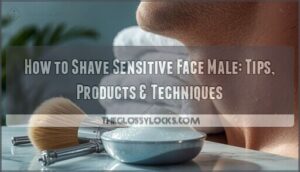This site is supported by our readers. We may earn a commission, at no cost to you, if you purchase through links.

The truth is, your skin’s protective barrier weakens during shaving, and when you’re already dealing with irritation, each stroke compounds the damage. Over 60% of women under 35 report skin sensitivity, yet few understand that proper shaving preparation isn’t about expensive products—it’s about timing, technique, and respecting your skin’s natural defenses.
The difference between a comfortable shave and days of regret comes down to what you do in the three minutes before the blade touches your face.
Table Of Contents
Key Takeaways
Hydrating your skin and softening facial hair for at least three minutes before shaving helps prevent irritation and razor burn.
Gentle exfoliation two to three times a week reduces ingrown hairs and improves razor efficiency, making shaving smoother for sensitive skin.
Choosing fragrance-free shaving products and sharp, high-quality razors protects your skin barrier and minimizes inflammation.
Shaving with the grain using light pressure and moisturizing immediately after shaving keeps your skin comfortable and lowers the risk of redness and infection.
Why Shaving Irritates Sensitive Skin
When you drag a razor across your face, you’re doing more than trimming hair—you’re scraping away the outermost layer of skin cells with every stroke.
For sensitive skin, this creates a perfect storm of irritation that normal skin can usually tolerate.
Let’s look at what’s actually happening beneath the surface and why your skin reacts differently.
Common Causes of Shaving Irritation
Friction from your razor scrapes away your skin’s protective barrier, leaving it exposed and vulnerable. When you shave without proper prep, three main issues arise:
- Mechanical trauma – Dull blades and repeated passes create micro-abrasions that trigger razor burn and skin inflammation.
- Barrier disruption – Stripping natural oils increases water loss and heightens irritant reactions.
- Chemical sensitivity – Fragrances and alcohol in products provoke contact dermatitis when shaving sensitive skin.
Dry shaving or going against the grain compounds these problems, leading to ingrown hairs and persistent redness. To minimize these issues, consider using natural skincare products that support skin health and reduce irritation.
Differences Between Sensitive and Normal Skin
Your skin barrier determines how you react to shaving. Sensitive skin has higher transepidermal water loss and lower hydration levels than normal skin, making it more prone to skin irritation. Women under 35 show the highest skin reactivity—over 60% report sensitivity.
Your nerve sensitivity is also heightened, with a lower threshold for triggering stinging and burning. That’s why shaving sensitive skin requires extra care to protect your compromised skin barrier.
Understanding the skin barrier function is essential for effective shaving preparation and maintenance of healthy skin.
Signs Your Skin Needs Extra Care
If you’ve noticed lingering redness, stinging, or tightness after shaving, your skin is sending clear signals that it needs a gentler approach. Watch for these irritation signs:
- Persistent skin redness lasting more than an hour after shaving
- Razor burn with burning sensations in sensitive areas
- Ingrown hairs forming raised bumps on your skin
- Flaking or dryness indicating compromised skin barrier function
These skin conditions tell you it’s time to adjust your shaving routine with extra care tips customized for sensitive skin.
Preparing Skin for a Gentle Shave
Getting your skin ready makes all the difference between a smooth shave and a rough one. The right prep work softens hair, protects your skin barrier, and cuts down on irritation before the razor even touches your face.
Here’s what you need to focus on.
Hydrating and Softening Facial Hair
Warm water isn’t just a comfort—it’s the foundation of every successful shave, transforming coarse facial hair into softer strands that your razor can glide through without tugging or irritation.
Hydrating your facial hair for at least three minutes allows warm water therapy to penetrate the hair follicle, softening each strand from root to tip.
This simple skin hydration method sets the stage for shaving preparation that protects sensitive skin care needs while reducing the risk of razor burn and inflammation.
Benefits of Exfoliation Before Shaving
Exfoliation acts as your skin’s reset button, sweeping away the dead cells that trap hair and dull your razor’s edge. When you exfoliate before shaving preparation, you’re reducing ingrown hairs by 59% and improving razor efficiency by 40%.
This skin smoothing step opens pores, softens stubble, and allows your blade to glide without dragging—cutting skin irritation dramatically.
For sensitive skin care, gentle exfoliation methods two to three times weekly provide pore minimization and hair softening benefits that transform your shave from a chore into genuine relief.
Choosing The Right Cleansers and Scrubs
Your cleanser isn’t just washing away yesterday’s grime—it’s setting the stage for whether your next shave soothes or punishes your skin. Choose formulas that exfoliate without waging war on your skin barrier.
- Natural Cleansers with glycolic acid gently dissolve dead cells without harsh scrubbing
- Soothing Scrubs containing jojoba beads provide mechanical exfoliation minus the microtears
- Facial Steaming opens pores before applying your facial scrub for deeper skin care benefits
- Preshave oil layered after cleansing creates a protective buffer that prevents skin irritation
Selecting Shaving Tools for Irritated Skin
The right tools make all the difference when your skin’s already on edge. Choosing a razor, shaving product, and formula that won’t add fuel to the fire takes some know-how.
Here’s what works best for irritated skin.
Best Razors for Sensitive Skin
Choosing the right razor can mean the difference between smooth comfort and days of irritation. For sensitive skin, blade design and materials matter more than marketing claims. Sophisticated multiblade razors with closely-spaced blades distribute pressure evenly across your skin, reducing trauma with each pass. The SkinGuard Sensitive Skin Razor exemplifies this approach, minimizing contact while delivering a close shave. Single-blade safety razors offer precision control, preventing the tugging that triggers razor burn.
Match your razor to your Skin Type Classification and Shaving Frequency. Replace blades every five to ten shaves—dull blades drag and irritate. Consider Razor Grips with ergonomic grips for better shaving technique for sensitive skin, allowing light pressure and gentle strokes. Razor Blade Materials like stainless steel or platinum-coated edges stay sharper longer, reducing skin trauma between Blade Replacement Tips.
| Razor Type | Best For | Key Benefit |
|---|---|---|
| Multiblade (3-5 blades) | Daily shaving routine | Even pressure distribution prevents irritation |
| Single-blade safety razor | Precision and control | Clean cuts without hair tugging |
| Double-edge safety razor | Coarse hair on sensitive skin | Sharp blade reduces passes needed |
| Cartridge with skin guards | Frequent shavers | Built-in protection minimizes nicks |
Shaving Creams, Gels, and Soaps to Use
The barrier between your blade and your skin isn’t optional—it’s the single most important factor in preventing post-shave irritation. Quality shaving cream or shave gel builds a protective lather that hydrates sensitive skin throughout each stroke.
Look for gentle formulas with natural ingredients like shea butter or avocado oil that soften hair and reduce drag. Shaving oils work beneath foam texture for extra glide, while traditional shaving soap creates rich cushioning when you need maximum protection.
Avoiding Harsh Ingredients and Scents
What lurks in that pleasant-smelling foam might be sabotaging your shave before the blade even touches your face. Artificial scents and harsh chemicals trigger skin irritation in sensitive skin types, even before you start shaving.
Choose fragrance-free, gentle formulas with natural soaps that protect your skin barrier instead of stripping it. Chemical avoidance isn’t paranoia—it’s practical skin sensitivity management that prevents razor burn before it starts.
Effective Shaving Techniques to Prevent Irritation
Once you’ve got the right tools, your technique makes all the difference. How you hold the razor, which direction you shave, and how much pressure you apply can either soothe your skin or set it on fire.
Let’s break down the methods that keep irritation at bay.
Mapping and Shaving With The Grain
Shaving against your hair’s natural direction might feel like the fast track to smoothness, but it’s actually the surest way to turn sensitive skin into a battlefield of razor burn and ingrown hairs. That’s why grain mapping matters. Before you pick up your razor, spend a minute running your fingertips across your face to identify which way your hair grows.
- Map your grain patterns: Hair doesn’t grow uniformly—your cheeks might go downward while your neck angles sideways
- Follow the natural hair direction: Shaving with the grain means fewer passes and less trauma to your skin barrier
- Maintain proper skin tension: Gently stretch the area you’re shaving to create a smooth surface for the razor
- Adjust your razor angles: Keep the blade at a 30-degree angle to avoid scraping or tugging
Using Light Pressure and Gentle Strokes
Once you’ve mapped your hair’s growth patterns, your next task is learning to let the razor glide instead of forcing it. Pressing hard doesn’t give you a closer shave; it just strips away your skin’s protective barrier. Think of it like steering a car: gentle strokes with light pressure give you control and protect sensitive skin from trauma.
| Shaving Technique | Why It Matters | Skin Hydration Methods |
|---|---|---|
| Light gentle strokes | Reduces micro-cuts and inflammation | Apply warm water for 3+ minutes |
| Sharp, clean blades | Prevents tugging and irritation | Use nondrying shaving cream |
| Minimal passes | Limits barrier disruption | Moisturize immediately after |
Your razor blade maintenance routine directly impacts how much pressure you need. Dull blades force you to press harder, creating a vicious cycle of irritation.
Preventing Ingrown Hairs and Razor Burn
Light pressure protects your skin, but your shaving routine needs more than gentle strokes to prevent razor burn and ingrown hairs. Around 60% of adults deal with ingrown hairs at some point, especially in sensitive areas.
Chemical exfoliants like glycolic or salicylic acid clear dead cells that trap hair beneath the surface, cutting recurrence by 28%. Pair these skin exfoliation methods with alcohol-free post-shave serums containing tea tree oil or witch hazel for razor burn relief.
Don’t forget shaving cream alternatives rich in shea butter—they reduce drag and keep your skin barrier intact.
Soothing and Protecting Skin After Shaving
What you do after shaving matters just as much as how you shave. Your skin needs immediate care to close pores, restore moisture, and prevent irritation from turning into infection.
Here’s how to protect your skin right after you put down the razor.
Cooling and Moisturizing Post-Shave Care
After you shave, your skin craves two things: cooling relief and deep hydration to lock in moisture and calm inflammation. Splash cold water on your face or apply a cold compress to close pores and reduce redness.
After shaving, your skin needs cooling relief and deep hydration to soothe irritation and lock in essential moisture
Follow with a fragrance-free moisturizer or aftershave lotion designed for sensitive skin. Soothing gels with aloe or aftershave balms create a protective barrier that aids postshave skin care and prevents flakiness.
Preventing Infections and Razor Bumps
Even minor nicks from shaving create openings for bacteria, raising your skin infection risk markedly. Razor bumps and folliculitis develop when hair curls back into skin or bacteria invade irritated follicles.
Protect yourself with these post-shave care tips:
- Apply diluted tea tree oil or soothing ingredients like chamomile to prevent infections
- Use over-the-counter hydrocortisone cream for razor burn prevention
- Rinse with cool water immediately after shaving to close pores
- Avoid tight clothing that traps moisture and worsens skin irritation
Replace razors every five to seven shaves to minimize ingrown hair treatment needs.
Storing and Cleaning Your Razor Properly
Your razor’s cleanliness determines whether your next shave soothes or inflames already irritated skin. Rinse blade edges thoroughly after each stroke to remove trapped hair and shaving cream.
Here’s proper Razor Hygiene:
| Maintenance Task | Frequency |
|---|---|
| Rinse blades during shaving | After each stroke |
| Deep clean grip | Weekly |
| Replace razor blades | Every 5-7 shaves |
Store your razor in a dry, ventilated area—never in the shower, where moisture breeds bacteria and dulls blade edges.
Frequently Asked Questions (FAQs)
How often should I replace my razor blade?
Most dermatologists recommend replacing razor blades every five to seven shaves to maintain blade sharpness and prevent irritation.
Dull razors tug at hair, increasing your risk of nicks, razor burn, and skin trauma—making blade replacement tips essential for healthy shaving routines.
Can I shave daily with sensitive skin?
If you have sensitive skin, daily shaving risks irritation and weakens your skin barrier.
Adjust your shave frequency and routine. Use gentle shaving techniques, hydrating products, and skin care tips to protect sensitive skin types from flare-ups.
What ingredients should I avoid in products?
Products containing harsh chemicals, artificial fragrances, or alcohol often trigger skin irritation.
Look for sulfate-free options, paraben alternatives, and natural oils instead. These choices help protect sensitive skin and reduce the risk of redness or discomfort.
How long should I wait between shaves?
Think of Shave Frequency as a balancing act—your skin needs Healing Time to recover.
For sensitive skin, waiting two to three days between shaves lets Skin Regeneration catch up, reduces razor burn, and keeps your shaving routine comfortable.
Should I shave before or after showering?
For ideal Shave Timing, it’s best to shave after showering. The Shower Sequence hydrates skin and softens hair, making Razor Preparation easier.
This Pre-Shave Routine reduces skin irritation, especially if you have sensitive skin.
Conclusion
If you think shaving preparation for irritated skin is a hassle, consider how much discomfort you save by investing a few mindful minutes. Your skin’s natural defenses are worth respecting, and gentle techniques make a noticeable difference.
Choosing the right products and tools isn’t about luxury—it’s about protecting what matters. When you treat your skin with care, you reclaim comfort and control.
The next shave is no longer a gamble, but a routine your skin can trust.
- https://providers.clevelandclinic.org/provider/shilpi-khetarpal/4268654
- https://my.clevelandclinic.org/health/diseases/17722-ingrown-hair
- https://pubmed.ncbi.nlm.nih.gov/27212465/
- https://www.researchgate.net/publication/385479013_Mechanisms_of_Sensitive_Skin_and_the_Soothing_Effects_of_Active_Compounds_A_Review
- https://www.ncbi.nlm.nih.gov/books/NBK547754/









